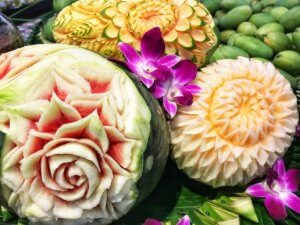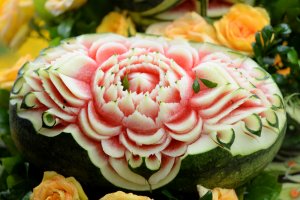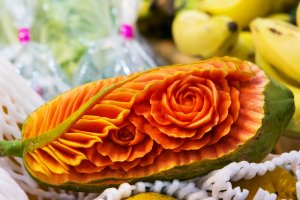Discover Mukimono Art Party Decorations

You might have seen mukimono decor in a Japanese restaurant, or used as party decorations. However, you probably didn’t know its name, or its origins.
So, in the following article, we want to tell you everything you need to know about mukimono art. If you have a meeting, dinner or party, this is the perfect way to decorate your home.
Origins and characteristics of mukimono art

First things first, we would like to define what mukimono art is. Mukimono art is a technique which involves carving fruit and vegetables, using tools to give them a different shape and even different colors to match the decor in the room. They can be used as decorations (for example, as table centerpieces) or served as desserts or side dishes.
Mukimono art first emerged in Japan and was originally religious in nature. The Japanese offered these stunning pieces of art to the gods as a gift of thanks. It is inspired by the Japanese flower art known as ‘ikebana‘, which symbolizes the union between the heavens, the earth, and mankind.
Oriental peoples would honor the Greeks with banquets when they first came to their lands and would offer them these carved fruits. In this way, the practice spread to Europe and continued to be used throughout ancient Rome. From there, it traveled to Egypt, where it was refined by none other than Cleopatra herself.
Mukimono art

This form of art is mainly used in Asia. Each country has its own techniques, based on their own customs and ancestral teachings. As well as Japanese and Chinese variants, Thai mukimono art is one of the most famous varieties. These types differ greatly from one another, each with its own special characteristics.
The vegetables most commonly used in mukimono art are carrots, cucumbers, eggplants, peppers, celery, pumpkin, onions, and radishes. As for fruit, artists often use watermelon, pineapple, apple, melon, papaya and citrus fruits (like orange and lemon).
The purpose of mukimono art is to highlight the colors and shapes of the fruit or vegetables, but it also offers an alternative way to enjoy their taste and smell. And, of course, you can’t forget the decorative aspect, which is the main purpose of these sculptures.
Mukimono art: techniques
Among the most common techniques used in mukimono art are high relief, which involves carving the fruit or veg so that more than half of it projects out from the background. You can also find medium relief (using half the fruit or vegetable) and low relief, using less than half of the fruit or veg.
Another technique is concatenation, which involves combining various pieces to create a larger piece, more stunning and elaborate than smaller pieces.
Usually people sculpt plants, flowers, patterns, landscapes, letters, leaves, geometric shapes and animals.

How you cut the fruit or veg depends on the texture and the tools you use. The pallet knives and scalpels used are fine and very sharp. They are similar to the tools used for carving wood and creating religious altarpieces.
In Japan, anyone with the skill to use knives and needles to create mukimono art is considered a true artist. And they really are. These pieces look almost too good to eat.
Once carved, people usually keep them in water or ice so they don’t lose their shape, and to prevent browning. Others keep them in lemon juice or vinegar.
When you hear the word cuisine, you probably think of your favorite food or a famous restaurant. However, although many believe better suits an art gallery than the dining room table, mukimono art also forms part of this world.
You might have seen mukimono decor in a Japanese restaurant, or used as party decorations. However, you probably didn’t know its name, or its origins.
So, in the following article, we want to tell you everything you need to know about mukimono art. If you have a meeting, dinner or party, this is the perfect way to decorate your home.
Origins and characteristics of mukimono art

First things first, we would like to define what mukimono art is. Mukimono art is a technique which involves carving fruit and vegetables, using tools to give them a different shape and even different colors to match the decor in the room. They can be used as decorations (for example, as table centerpieces) or served as desserts or side dishes.
Mukimono art first emerged in Japan and was originally religious in nature. The Japanese offered these stunning pieces of art to the gods as a gift of thanks. It is inspired by the Japanese flower art known as ‘ikebana‘, which symbolizes the union between the heavens, the earth, and mankind.
Oriental peoples would honor the Greeks with banquets when they first came to their lands and would offer them these carved fruits. In this way, the practice spread to Europe and continued to be used throughout ancient Rome. From there, it traveled to Egypt, where it was refined by none other than Cleopatra herself.
Mukimono art

This form of art is mainly used in Asia. Each country has its own techniques, based on their own customs and ancestral teachings. As well as Japanese and Chinese variants, Thai mukimono art is one of the most famous varieties. These types differ greatly from one another, each with its own special characteristics.
The vegetables most commonly used in mukimono art are carrots, cucumbers, eggplants, peppers, celery, pumpkin, onions, and radishes. As for fruit, artists often use watermelon, pineapple, apple, melon, papaya and citrus fruits (like orange and lemon).
The purpose of mukimono art is to highlight the colors and shapes of the fruit or vegetables, but it also offers an alternative way to enjoy their taste and smell. And, of course, you can’t forget the decorative aspect, which is the main purpose of these sculptures.
Mukimono art: techniques
Among the most common techniques used in mukimono art are high relief, which involves carving the fruit or veg so that more than half of it projects out from the background. You can also find medium relief (using half the fruit or vegetable) and low relief, using less than half of the fruit or veg.
Another technique is concatenation, which involves combining various pieces to create a larger piece, more stunning and elaborate than smaller pieces.
Usually people sculpt plants, flowers, patterns, landscapes, letters, leaves, geometric shapes and animals.

How you cut the fruit or veg depends on the texture and the tools you use. The pallet knives and scalpels used are fine and very sharp. They are similar to the tools used for carving wood and creating religious altarpieces.
In Japan, anyone with the skill to use knives and needles to create mukimono art is considered a true artist. And they really are. These pieces look almost too good to eat.
Once carved, people usually keep them in water or ice so they don’t lose their shape, and to prevent browning. Others keep them in lemon juice or vinegar.
When you hear the word cuisine, you probably think of your favorite food or a famous restaurant. However, although many believe better suits an art gallery than the dining room table, mukimono art also forms part of this world.
All cited sources were thoroughly reviewed by our team to ensure their quality, reliability, currency, and validity. The bibliography of this article was considered reliable and of academic or scientific accuracy.
Di Clemente, E., Hernández Mogollón, J. M., & López-Guzmán, T. (2014). La gastronomía como patrimonio cultural y motor del desarrollo turístico. Un análisis DAFO para Extremadura. Educación.







